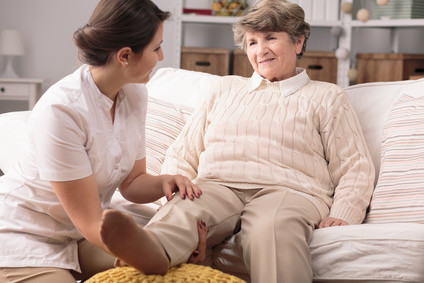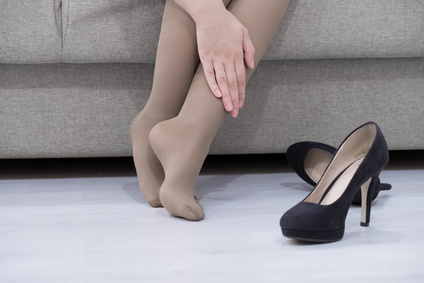Swollen Leg and Swelling of the Feet, Ankle and Toes
Swelling of the leg may involve a noticeable distension of the shin or calf, ankles, feet or toes. Foot swelling may be a common occurrence which most of us will experience at some point in life after a long day of standing or sitting but may also be an indication of a more serious pathology as in certain cardiovascular disorders. Recurrent or persistent swelling of the feet should be investigated by a medical practitioner especially if you have a history of cardiovascular disease or have noticed a change in color, sensation or mobility of the leg, foot or toe.
Blood rich in oxygen and nutrients flow through the arteries to the target area. Blood carrying deoxygenated blood returns to the heart via the veins where it is quickly routed to the lungs to be replenished with oxygen. Blood flowing to the leg has to return to the heart through a group of veins with intermittent valves located throughout the course of the vein.
This venous blood (blood in the veins that is returning to the heart) has to flow against gravity and since the pressure is usually lower at the feet, other muscles of the leg assist with ‘pumping’ this blood back to the heart. This muscle pump is most active when we are walking and least when we are standing stationary or sitting. Blood travels short distances up the vein and back flow of blood is prevented by a series of valves in these veins.

Working alongside the blood vessels are the lymphatic vessels which returns lymphatic fluid (lymph) back up the body to empty into the blood system. Swelling of the leg usually occurs as a result of inadequate flow of blood or lymphatic fluid back up to the torso of the body. However, other localized causes may further contribute to swollen feet, ankles or toes.
Causes of a Lower Limb Swelling
The following causes may be responsible for swelling of the leg, ankles, feet and toes. It is important that lower leg swelling is assessed by a medical professional. Some of these causes can be serious and even life threatening.
1. Inflammation
- Injury
- Allergies
- Insect bites
- Exertion
- Phlebitis
- Lymphedema
- Baker’s Cyst

2. Infection
- Cellulitis
- Athlete’s foot – severe cases of tinea pedis followed by secondary bacterial infection may cause swelling of the feet.
3. Obstructed or Impaired Blood Flow
- Varicose veins
- Peripheral vascular disease
- Venous ulcers
- Diabetic ulcers
- Thrombophlebitis
- Deep vein thrombosis (DVT)
4. Systemic & Miscellaneous Causes
- Generalized edema (edema throughout the body)
- Congestive cardiac failure
- Kidney failure
- Liver failure or cirrhosis of the liver
- Rheumatoid arthritis
- Gout (swelling of the toes)
- Pregnancy – refer to Pregnancy Leg Swelling
- Immobility
- Prolonged standing or sitting

Symptoms
Swelling of the lower extremity may be clearly visible or detected as pitting edema and may be accompanied with other symptoms (concomitant).
- Distortion of the anatomy of the leg, foot, ankle or toe.
- Pain (claudication is pain of the calf muscle upon strain or intermittent)
- Numbness or tingling.
- Pale, red, blue to purple or black discoloration.
- Itching with or without a rash.
- Excessive warmth or cold and clammy skin.
- Impaired mobility either due to loss of muscle control or weakness.
Chest pain and shortness of breath are some of the serious symptoms that can follow lower leg swelling which may be due to deep vein thrombosis (DVT). The risk in DVT is that the clot may dislodge from the leg vein and obstruct the blood vessels of the lungs which can be fatal.
Diagnosis
Swelling of the leg, foot, ankle or toes may be clearly visible and if one sided (unilateral), it should be compared to the other limb to verify the swelling. In cases of pitting edema, pressure with a finger on the swollen area will leave a finger imprint for a few seconds to a few minutes after the finger pressure is discontinued.
There are two pedal (foot) pulses that are palpable, the dorsalis pedis pulse can be felt on the top of the foot or the tibialis pedis pulse which can be felt on the inner ankle. Feint or absent pulses may assist with identifying any factors reducing or obstructing blood flow. A swollen leg may be indicative of other diseases and further investigation may be required.
Treatment
Treatment is dependent on the cause of the swollen legs, feet, ankle or feet.
- Diuretics may be useful for water retention (edema) especially in generalized edema as it increases the passing out of fluid. It is not advisable for women who are pregnant or recently given birth to use diuretics unless advised by their medical practitioner.
- Antibiotics may be required for infections. Antimicrobial creams, gels or sprays may be useful for treating venous or diabetic ulcers.
- Anti-clotting or anti-coagulating agents like warfarin may be useful for thrombophlebitis and deep venous thrombosis (DVT).
- Anti-inflammatory drugs may assist with pain and inflammation or rheumatoid arthritis.
- Corticosteroids may be useful for allergic or autoimmune causes of a swollen leg, foot, ankle or toe.
- Anti-gout drugs are necessary for long term management of gout which can cause a painful swelling of the toe, especially the big toe.
Management
Management should be directed at the causative factors and it is advisable that you seek advice from your medical practitioner before you attempt to manage your swollen legs conservatively.
- Walking or moving your legs, feet or toes may assist with swelling when standing stationary or sitting for long periods. This is especially important for frequent flyers and those prone to deep venous thrombosis as the long flights and restricted space can aggravate DVT and swelling of the legs.
- Varicose vein sufferers may benefit from the usage of compression stockings. However it is usually not advisable to use compression stockings if you suffer with peripheral vascular disease as this may aggravate or complicate your condition. Consult with your medical practitioner before using compression stockings for your swollen legs.
- Raising your legs to body level when sitting can assist with swelling but be cautious about elevating the legs significantly higher than the torso when sleeping. This is not advisable in certain conditions affecting the heart, liver or kidney. Medical advice should be sought.
- Reducing your salt and electrolyte intake (low sodium diet) may be advisable in certain conditions (like kidney failure) although this diet may not directly reduce leg swelling.
Last updated on October 9, 2018.




